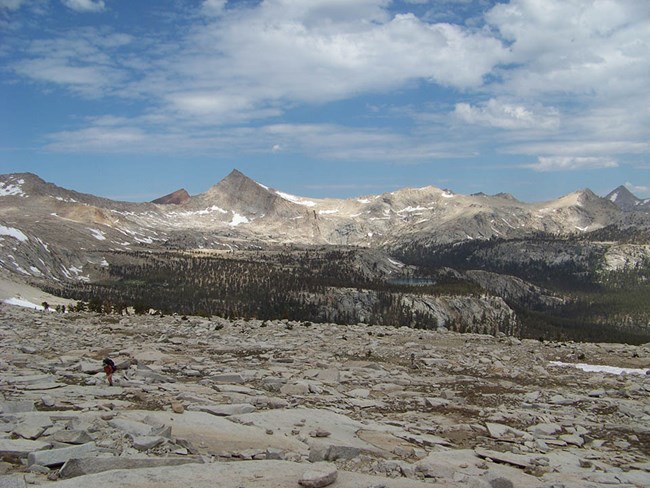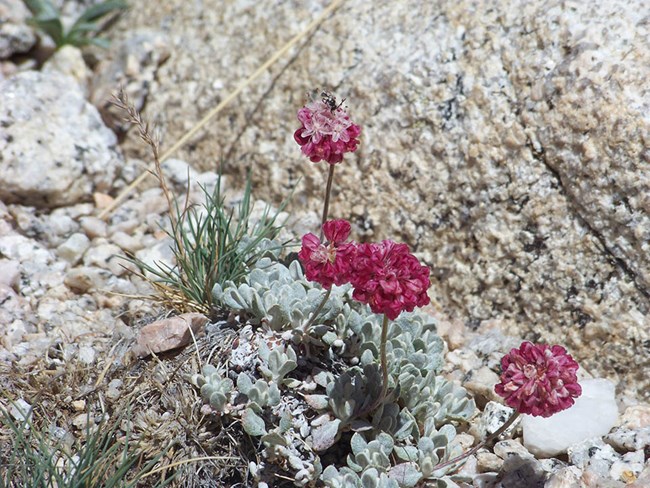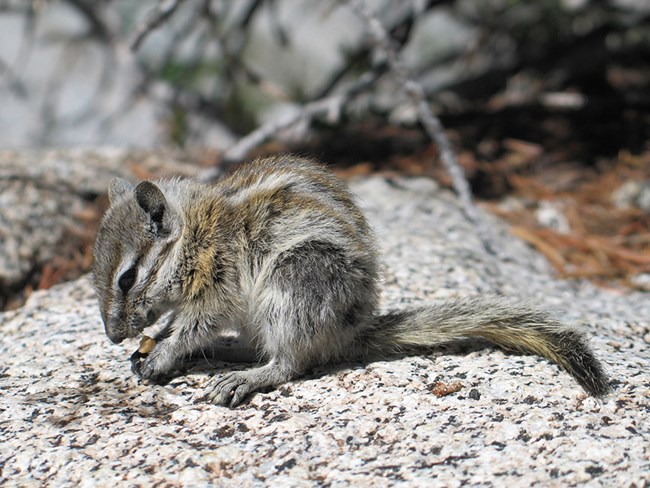
Photo by Lyndsay Belt In the rocky alpine, where the short growing season and harsh winter conditions exclude all but the hardiest of plants, stunted trees give way to low-growing, perennial herbs. Here plants often form ground-hugging mats or hummocks to take advantage of the warmer surface temperatures. In winter, the snowpack provides insulation from sub-freezing temperatures and desiccating winds. During the brief summer, when freezing temperatures and snowstorms remain a threat, surprisingly showy flowers burst forth in the race to set seed before winter returns.
With over 48 percent of Sequoia and Kings Canyon National Parks occurring above 10,000 feet, high-elevation habitats dominate these parks. Crowning the tops of the mountains, the alpine zone is biologically rich despite harsh growing conditions. Approximately 600 species of vascular plants grow in these areas, with at least 200 of those being restricted only to the alpine zone. With its scattered lakes, meadows, rugged peaks, vivid flowers, and scenic vistas, the alpine zone draws over 100,000 visitors each year, most of them traveling on foot to these remote wilderness landscapes. 
Photo by Lyndsay Belt Life in the AlpineThe alpine environment provides primary habitat for a number of sensitive or at-risk organisms in these parks, including American pika, Sierra Nevada bighorn sheep, Yosemite toad, mountain yellow-legged frogs, and 32 of the parks' special status plants. Characteristic bird species in the alpine include gray-crowned rosy finches and American pipits, which feed on insects near mountain lakes. Numerous animals that live across a wide elevation range visit the alpine to forage on plants or hunt for small mammals, amphibians, insects, and occasionally catch fish. Examples include black bears, coyotes, bats, and various birds of prey such as prairie falcons and golden or bald eagles. 
Photo by Leslie Chow ThreatsThe slow-growing perennial plants adapted to the extreme climatic conditions of high elevations may be particularly vulnerable to the shifts in temperature and snowpack dynamics anticipated with climate change. Scientists who have revisited early 1900s mammal survey sites in the Sierra Nevada have documented range contractions or upward shifts in several species of small mammals, with climate change being the most probable driver of these range changes.
Non-native fish and non-native pathogens (chytrid fungus) have historically had the greatest impact on alpine communities that are evident today. Alpine aquatic systems have been profoundly altered by the past establishment of non-native trout and the recent emergence of chytrid fungus, both of which are linked to the decline of mountain yellow-legged frogs. Remaining populations of the federally endangered Sierra Nevada bighorn sheep remain at risk from diseases carried by domestic sheep pastured outside of the parks.
The Sierra Nevada mountains receive a stream of pollutants and contaminants transported by air from regional agricultural and urban centers. The long-term effect of these inputs on alpine organisms is a subject of on-going research. More InformationTo learn more about the alpine ecosystem, visit the following links: |
Last updated: June 21, 2025
